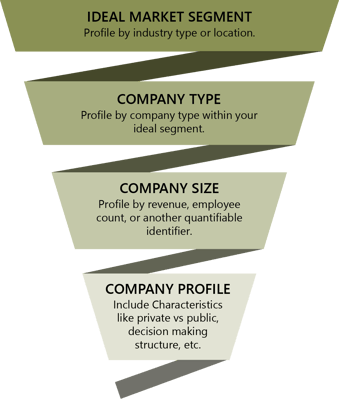
How many of you know who your ideal clients are? You might be thinking, “Of course I do! I completely understand my ideal clients.” But can you describe in clear detail exactly who these ideal clients (sometimes called buyer personas) are, what they want and need, what makes them tick? You might be surprised to learn that only 44% of B2B marketers use buyer personas. In fact, in my experience in the manufacturing and industrial space, while most companies have an idea, many have not developed a complete picture of their ideal customer.
Much has been written about the importance of buyer personas, but according to research by Sirius Decisions, “60-70% of B2B marketers admit that they don’t truly understand their buyers.” I don’t want to be part of that statistic (and you probably don’t either). That’s why during every sales discovery conversation with a new client, when I’m asking questions to learn as much as I can about their goals, needs, and challenges, I ask them to define their ideal client. Initial answers frequently sound like:
- the automotive (or aerospace, or some other category) industry
- engineers
- purchasing agents
- casting companies
- machine builders
- and so on
Those are pretty general terms. But as I begin to dig further, it usually becomes clear there is a much greater understanding of who that target is. Unfortunately, that understanding is often “insider” knowledge embedded in the sales team’s and owners’ heads. It is almost never documented or truly spelled out. I admit, we all can get caught up in generalities. The problem is that if you remain in the world of generalities, you end up spending a great deal of time chasing bad business and quoting projects that might not make sense for your company. If you happen to land one of those prospects defined by generalities, they often don’t last long or can become a ‘problem’ customer. That’s not a great way to grow your business. On the other hand, “Companies who exceed lead and revenue goals are over twice as likely to formally document personas than companies who underperform in these areas “
Logically, without defining an ideal client and how to engage with them, how can we create a scoring system to evaluate whether this prospect should be pursued? It seems fundamental, but it’s often neglected, as I recently experienced with a client. In the long run, it’s worth the effort to do correctly. The goal is to understand who your target is and what their needs and buying style look like. I view this process like a funnel: start at the highest level and drill down.

- Ideal Market Segment(s) – Profile by Industry type, possibly geography if your company is a regional player
- Company Type Within Segment(s)
- Company Size – Could be by revenue, employee count, or another quantifiable identifier
- Company Profile – Including characteristics like privately held companies versus public, decision making structure, company culture, etc.
The clearer you make your definition, the easier it is to target the right prospects. For example, your high-level definition might look like this:
We work nationally with Tier 1 suppliers/manufacturers of electronic control systems for the electric vehicle market. These companies could be privately or publicly held with an annualized revenue of over 50M dollars.
This may be just one of many company profiles your company targets but by having a tighter definition, you provide clarity and direction and set the basis for opportunity targeting.
But you’re not quite done yet. The next step is to define the people within the organization that you’ll be dealing with, in other words, the buyer personas.
In order to truly understand your prospect, you should look at these things:
- Typical Title Profile
- Demographic information such as age, seniority in company, etc.
- Job Responsibilities
- Preferred form(s) of communication
- Goals and Objectives
- Biggest challenges they face
- How (and when? or how often?) they gather information
As with your company profile, the more detailed the definition, the tighter your targeting can be. As an example, your finished persona definition could be: The key decision maker at my ideal client works in Purchasing or Procurement. They are typically in the range of 25-40 years old. Their job responsibilities include:
- Soliciting bid proposals
- Issuing purchase orders
- Researching and evaluating suppliers based on quality, service, reliability, capabilities, and reputation
- Coordinating with internal engineering department and collaborating on technical requirements
- Reviewing final submittals with internal teams and awarding contracts
Their goals and objectives include:
- minimizing cost of suppliers
- maintaining value
- adhering to quality goals
- building strategic relationships
- consolidating vendors used
- assuring supplier efficiencies
Their biggest challenges include:
- Supplier inflexibility
- Pricing (e.g. fluctuations in commodities markets)
- Damaged or below-quality supply
- Logistics (e.g. location, transport, inventories)
When performing their job, the purchasing or procurement person gathers and collects information via the internet (e.g. online catalogs, supplier portals, sourcing platforms such as ThomasNet.com, Google search, websites), trade journals, trade shows, and industry publications.
Now that you have a clear definition of not only the company type, but also your contact type, you can build a strong, highly targeted sales and marketing plan. You can create very specific messaging and relevant content that resonates with your ideal buyer by design, and you can strategically deliver it to the places your prospect searches.
Additionally, you can use these company profile and persona definitions to build a client attractiveness index or scale and score the companies you are building opportunities with. Scoring prospects helps you make decisions about how much time and resources to invest (if any) in pursuing them. By focusing on the ideal client, you increase your sales and marketing efficiency, your company profitability, and maintain clarity throughout your organization.
If all of this has you rethinking how well you know who your ideal customers are, contact us. We can help you with this critical step in sales and marketing planning.
